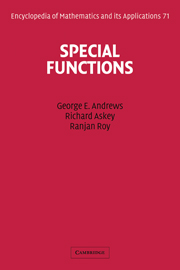Book contents
- Frontmatter
- Contents
- Preface
- 1 The Gamma and Beta Functions
- 2 The Hypergeometric Functions
- 3 Hypergeometric Transformations and Identities
- 4 Bessel Functions and Confluent Hypergeometric Functions
- 5 Orthogonal Polynomials
- 6 Special Orthogonal Polynomials
- 7 Topics in Orthogonal Polynomials
- 8 The Selberg Integral and Its Applications
- 9 Spherical Harmonics
- 10 Introduction to q-Series
- 11 Partitions
- 12 Bailey Chains
- A Infinite Products
- B Summability and Fractional Integration
- C Asymptotic Expansions
- D Euler–Maclaurin Summation Formula
- E Lagrange Inversion Formula
- F Series Solutions of Differential Equations
- Bibliography
- Index
- Subject Index
- Symbol Index
4 - Bessel Functions and Confluent Hypergeometric Functions
Published online by Cambridge University Press: 05 May 2013
- Frontmatter
- Contents
- Preface
- 1 The Gamma and Beta Functions
- 2 The Hypergeometric Functions
- 3 Hypergeometric Transformations and Identities
- 4 Bessel Functions and Confluent Hypergeometric Functions
- 5 Orthogonal Polynomials
- 6 Special Orthogonal Polynomials
- 7 Topics in Orthogonal Polynomials
- 8 The Selberg Integral and Its Applications
- 9 Spherical Harmonics
- 10 Introduction to q-Series
- 11 Partitions
- 12 Bailey Chains
- A Infinite Products
- B Summability and Fractional Integration
- C Asymptotic Expansions
- D Euler–Maclaurin Summation Formula
- E Lagrange Inversion Formula
- F Series Solutions of Differential Equations
- Bibliography
- Index
- Subject Index
- Symbol Index
Summary
In this chapter, we discuss the confluent hypergeometric equation and the related Bessel and Whittaker equations. The Bessel equation is important in mathematical physics because it arises from the Laplace equation when there is cylindrical symmetry. The confluent hypergeometric equation is obtained when we start with a second-order differential equation whose only singularities are regular singularities at 0, b, and ∞; we let b → ∞. The resulting equation has ∞ as an irregular singular point obtained from a confluence of two regular singularities. Thus, the confluent equation can be derived from the hypergeometric equation by changing the independent variable x to x/b and letting b → ∞. The solutions are 1F1 functions, and some properties of these functions are limits of properties of 2F1 functions. However, it is often easier to derive the results directly than to justify the limiting procedures.
Whittaker transformed the confluent equation to one in which the coefficient of the first derivative is zero. Solutions of this equation are called Whittaker functions. We find their series and integral representations and their asymptotic behavior and then give some important examples such as the error function and the parabolic cylinder function.
The Bessel equation can be derived from a particular Whittaker equation and can be solved to obtain the Bessel functions to which we devote a good portion of this chapter. These functions are also important for their role in Fourier transforms in several variables.
- Type
- Chapter
- Information
- Special Functions , pp. 187 - 239Publisher: Cambridge University PressPrint publication year: 1999
- 1
- Cited by



